Maxwell Ochoo’s first attempt at farming was a dismal failure.
In Ochieng Odiere, a village near the shores of Kenya’s Lake Victoria, “getting a job is a challenge,” the 34-year-old says. To earn some money and help feed his family, he turned to farming. In 2017, he planted watermelon seeds on his 0.7-hectare plot.
Right when the melons were set to burst from their buds and balloon into juicy orbs, a two-month dry spell hit, and Ochoo’s fledgling watermelons withered. He lost around 70,000 Kenyan shillings, or about $650.
Can trees save the world?
Lately, society has been putting a lot of pressure on trees to get us out of the climate change emergency we’re in. There’s no doubt that trees make life better in many respects, but there are right ways and plenty of wrong ways to protect and grow the forests.
- Why planting tons of trees isn’t enough to solve climate change
- The first step in using trees to slow climate change: Protect the trees we have
Ochoo blamed the region’s loss of tree cover for the long dry spells that had become more common. Unshielded from the sun, the soil baked, he says.
In 2018, Ochoo and some neighbors decided to plant trees on public lands and small farms. With the help of nonprofit groups, the community planted hundreds of trees, turning some of the barren hillsides green. On his own farm, Ochoo now practices alley cropping, in which he plants millet, onions, sweet potatoes and cassava between rows of fruit and other trees.
The trees provide shade and shelter to the crops, and their deeper root systems help the soil retain moisture. A few times a week in the growing season, Ochoo takes papayas, some as big as his head, to market, bringing home the equivalent of about $25 each time.
And the fallen leaves of the new Calliandra trees provide fodder for Ochoo’s five cows. He also discovered that he could grind up the fernlike leaves as a dietary supplement for the tilapia he grows in a small pond. He now spends less on fish food, and the tilapia grow much faster than his neighbors’ fish, he says.
Today, nearly everything Ochoo’s family eats comes from the farm, with plenty left over to sell at market. “Whether during dry spell or rainy season, my land is not bare,” he says, “there’s something that can sustain the family.”
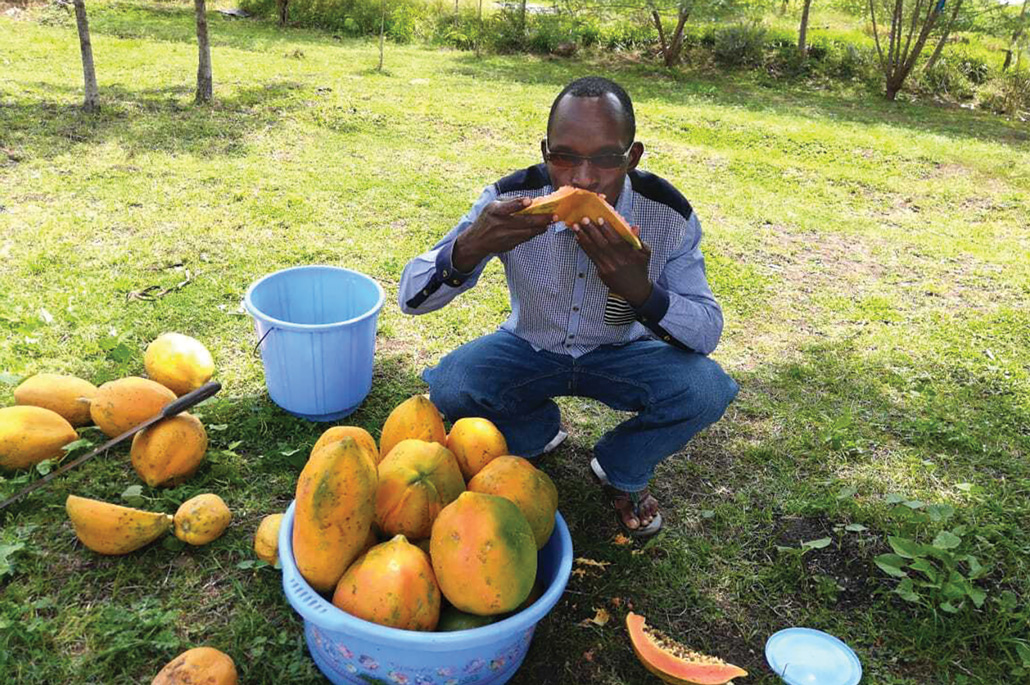 Maxwell Ochoo eats a juicy papaya from his farm in Kenya. Papaya trees help keep moisture in the soil in drier times, benefiting the crops he grows between the trees.M. Ochoo
Maxwell Ochoo eats a juicy papaya from his farm in Kenya. Papaya trees help keep moisture in the soil in drier times, benefiting the crops he grows between the trees.M. Ochoo
Ochoo’s tree-filled farm represents what many scientists hope will be farming’s future. The present reality, where fields are often cleared of trees to raise livestock or plant row after row of single crops, called monocultures, is running out of room.
About half of all habitable land on Earth is devoted to growing food. More than 30 percent of forests have been cleared worldwide, and another 20 percent degraded, largely to make room for raising livestock and growing crops. By 2050, to feed a growing population, croplands will have to increase by 26 percent, an area the size of India, researchers estimate.
Humans’ collective hunger drives the twin ecological crises of climate change and biodiversity loss. Cutting down trees to make room for crops and livestock releases carbon into the atmosphere and erases the natural habitats that support so many species (SN: 1/30/21, p. 5).
Humankind is in danger of crossing a planetary boundary with unpredictable consequences, says landscape ecologist Tobias Plieninger of Germany’s University of Kassel and University of Göttingen. As land continues to be cleared for agriculture, “there’s high pressure … to shift toward more sustainable land use practices.”
Farmers like Ochoo, who intentionally blend crops, trees and livestock, a practice loosely called agroforestry, offer a more sustainable way forward. Agroforestry may not work in every circumstance, “but it has great potential,” Plieninger says, for working toward food production and conservation goals on the same land.
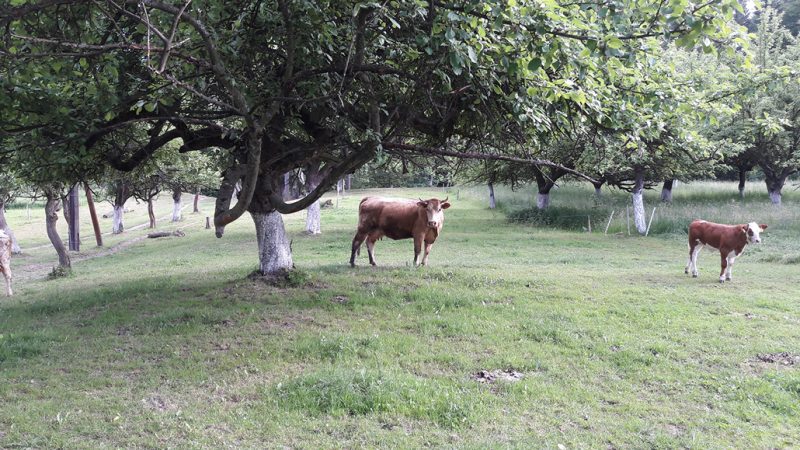 In one agroforestry project, cows graze among apple trees in an orchard in Poland.AGFORWARD PROJECT/FLICKR (CC BY-NC-SA 2.0)
In one agroforestry project, cows graze among apple trees in an orchard in Poland.AGFORWARD PROJECT/FLICKR (CC BY-NC-SA 2.0)
Integrating trees onto farms may seem like a recipe for lower yields, as trees would replace some crops. But such mixing can actually squeeze more food from a given plot of land than when plants are grown separately, Plieninger says. In Europe, blended farms that grow wheat or sunflowers between rows of wild cherry and walnut trees, for example, can produce up to 40 percent more than monocultures of the same crops for a given area.
Agroforestry was the norm until modern agricultural methods swept the globe, especially after the Industrial Revolution and the rise of chemical fertilizers in the mid-20th century. But small farms in the tropics are still big on trees. Worldwide, about 43 percent of land used for agriculture has at least 10 percent tree cover, according to a 2016 study in Scientific Reports.
In Europe, blended farms that grow wheat or sunflowers between rows of wild cherry and walnut trees, for example, can produce up to 40 percent more than monocultures of the same crops for a given area.
Increasing that percentage could have profound and wide-ranging benefits, if done right. “Trees have to be integrated [onto farms] to not create extra problems” for farmers, says Anja Gassner, a senior scientist at World Agroforestry in Bonn, Germany. And the approach looks very different depending on the region and the goals of the people who live there. What Spanish farmers need from their oak-dotted fields where pigs get fat on acorns will be different from what farmers in Ecuador want from their coffee plants growing under the cool shade of tropical inga trees.
The way agroforestry is carried out in three very different parts of the world illustrates the promises and challenges of coupling trees and crops.
Made in the shade
If you’re enjoying a morning cup of coffee while reading this, there’s a chance the beans in that brew came from farms practicing agroforestry.
Coffee plants evolved in the understory of Ethiopia’s highland forests; they are well-suited to shade, says Eduardo Somarriba, an agroecologist at the Tropical Agricultural Research and Higher Education Center in Cartago, Costa Rica.
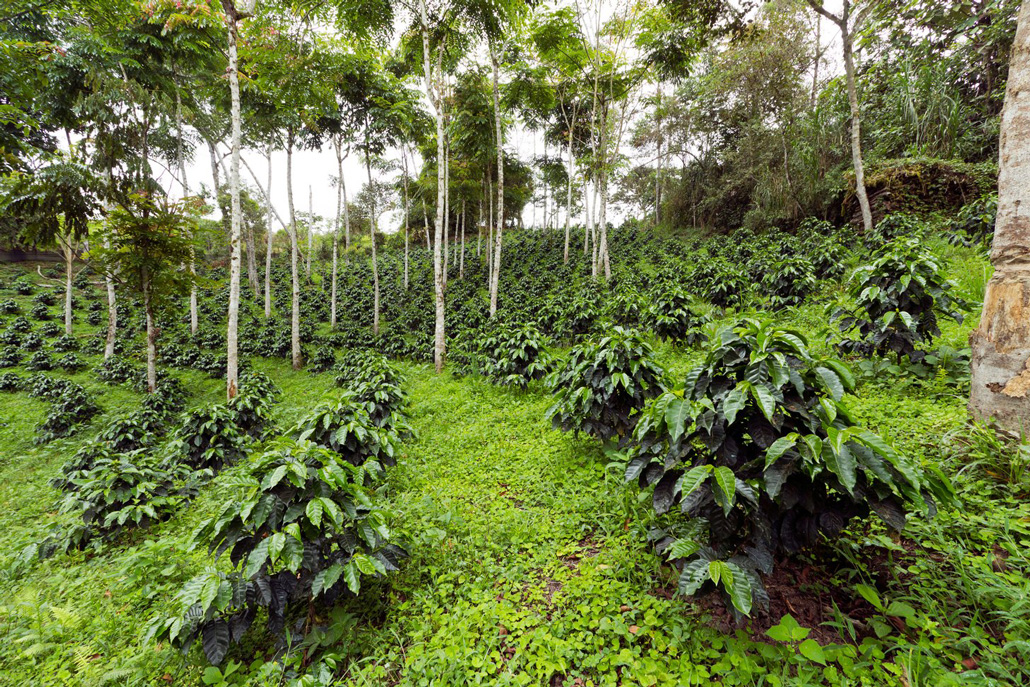 Rows of coffee plants are shaded by trees on this plantation in Ecuador. The trees help prevent the slopes from eroding and can be harvested to supply farmers with extra income.Morley Read/Alamy Stock Photo
Rows of coffee plants are shaded by trees on this plantation in Ecuador. The trees help prevent the slopes from eroding and can be harvested to supply farmers with extra income.Morley Read/Alamy Stock Photo
A diverse canopy of native trees can help coffee plants thrive. Certain trees pump nitrogen into the soil, removing the need for intensive fertilizer application, Somarriba says. Native vegetation suppresses weed growth, stabilizes soil and temperature, improves water retention and supports pollinating animals.
But as global thirst for coffee has grown, planting practices have shifted toward shadeless plots filled only with coffee plants that require a steady stream of chemical fertilizers. From 1996 to 2010, the worldwide share of coffee grown under a canopy of diverse trees fell from 43 percent to 24 percent, researchers reported in 2014 in BioScience.
Removing trees is seen as good for increasing yields, though the evidence is mixed. This focus on numbers misses the more diffuse benefits of diversifying farms, Somarriba says, especially small farms, which still produce most of the world’s coffee.
From 1996 to 2010, the worldwide share of coffee grown under a canopy of diverse trees fell from 43 percent to 24 percent.
“If coffee prices go down and stay low for five or six years, a small farmer will not be able to make it only from [selling] coffee,” Somarriba says. But adding a mix of trees can build in economic and climate resilience, he says.
Valuable timber trees, like mahogany, can serve as savings accounts, harvested when coffee profits aren’t enough. Mango, Brazil nut or acai trees can supply income, too. But not all places have well-developed markets for these goods, Somarriba says, which presents a challenge to increasing the share of coffee grown under shade.
Some conservationists are trying to boost consumer demand for shade-grown coffee by highlighting how it benefits biodiversity. The Smithsonian Migratory Bird Center, for example, grants a Bird Friendly certification to plantations with ample native tree cover and diversity, a boon for migratory birds. Certified farmers are able to charge a slightly higher price, on average 5 to 15 cents more per pound.
Migratory birds flock to such plantations. “When you’re in a bird-friendly coffee farm, it kind of feels like you’re in the forest,” says Ruth Bennett, an ecologist at the Smithsonian Migratory Bird Center in Washington, D.C. “You hear a lot of bird calls, and it’s a huge diversity of birds, including really sexy tropical species like the turquoise-browed motmot,” she says.
Bird Friendly coffee plantations also appear to be good for mammals. In Mexico, Bird Friendly coffee plantations had more native wildlife, including deer and mice, than other coffee plantations, according to a 2016 study in PLOS ONE.
Ecosystems brimming with diverse species of plants, animals and more make the planet livable by filtering water, cycling nutrients through soils and pollinating crops. While undeveloped forest is clearly best for biodiversity, shade-grown plantations can outshine other land uses. After more than a decade, high-diversity coffee agroforestry systems in southeastern Brazil were ecologically healthier — as measured by tree canopy cover and species richness — than plots set aside for nonagricultural restoration, researchers reported in the September 2020 Restoration Ecology. About 90 percent of the canopy was intact on shaded coffee plots versus about 60 percent for restored forest areas, on average.
Beyond the biodiversity benefits, Bennett says shade-grown coffee just tastes better. Under shade, coffee cherries take longer to develop, which can boost sugar content.

Sign Up For the Latest from Science News
Headlines and summaries of the latest Science News articles, delivered to your inbox
Client key* E-mail Address* Go
Thank you for signing up!
There was a problem signing you up.
Time to recover
In the Shinyanga region of Tanzania, a return to traditional Indigenous practices, with a dose of modern agroforestry, helped transform what was once the “desert of Tanzania” back into productive savanna woodlands.
The region, about a five-hour drive southeast from the Serengeti, is home to the Sukuma people, traditionally agropastoralists who raised livestock in the hilly grasslands of the region, dotted with acacia and oaklike miombo trees.
But in the 1920s, the landscape began to change. The British colonial government cut back woodlands in a misguided effort to control the tsetse flies that were harming livestock and humans and to plant cash crops like cotton. In the 1960s, forest loss accelerated when the government took ownership of many homesteads. After they lost rights to harvest products from the forest, local Tanzanians had less incentive to conserve the trees.
Within a few decades, the ecosystem had degraded into dry, dusty expanses largely devoid of trees. Food, firewood and water were scarce and local livelihoods suffered, says Lalisa Duguma, a sustainability scientist at World Agroforestry, an international research agency headquarted in Nairobi, Kenya.
By the 1980s, the situation had become so dire that the Tanzanian government intervened. At first, it tried to convince local residents to plant seedlings of fast-growing exotic trees, like eucalyptus, Duguma says. But locals weren’t interested in planting or tending those seedlings. In the face of this setback, experts and officials did something not always done in development projects: They listened.
“By just fencing in degraded land, the process of restoration starts.”
Lalisa Duguma
Listening to locals revealed that an age-old tradition of forming ngitilis could be the foundation for restoration. Roughly translated as “enclosure,” a ngitili cordons off a section of land for a year or two, allowing trees and grasses to recover, and then opening it to provide fodder for grazing animals during the dry season. “By just fencing in degraded land, the process of restoration starts,” Duguma says.
Native seeds and stumps long stunted by grazing or poor soil conditions can begin to grow again, and their numbers can be supplemented with planted trees. Local institutions largely planned and monitored ngitilis, in accordance with traditional practices, often in collaboration with government scientists.
Year by year, the benefits of ngitilis slowly accrued, giving shade and fodder to livestock and wood for energy and building. Maturing trees provided fruits and supported beehives for honey production.
At the start of the restoration in the mid-1980s, there were only 600 hectares of ngitilis in all of the Shinyanga region. After 16 years, more than 300,000 hectares of land was restored. The return of trees in the region may have sequestered more than 20 million metric tons of carbon over 16 years (the equivalent of taking 16.7 million cars off the road for a year), according to a 2005 report by the Tanzanian government and the International Union for the Conservation of Nature. Deeper root systems bolstered soil health, and expanded tree cover cut down on wind and water erosion, halting desertification.
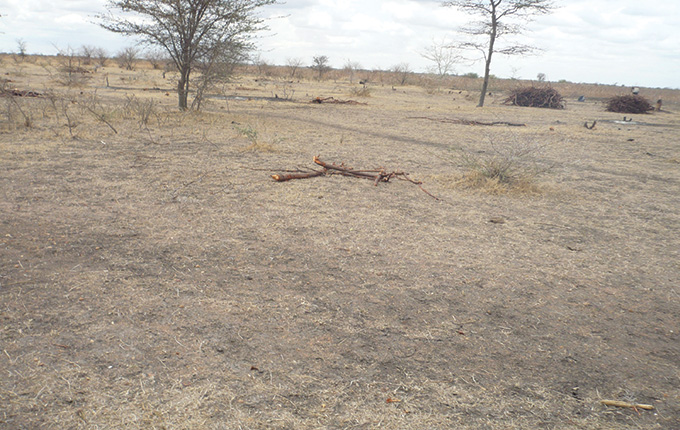 After decades of tree cutting, the landscape of Tanzania’s Shinyanga region dried up.Dr. Otsyina
After decades of tree cutting, the landscape of Tanzania’s Shinyanga region dried up.Dr. Otsyina 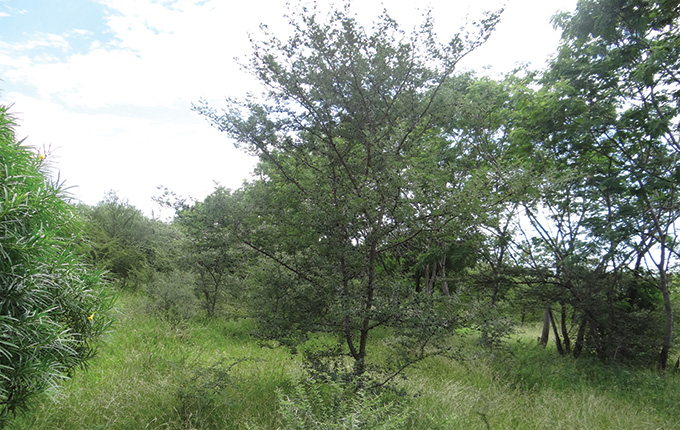 In the 1980s, a focus on creating reserves of plant life called ngitilis transformed the landscape.L.A. Duguma/World Agroforestry
In the 1980s, a focus on creating reserves of plant life called ngitilis transformed the landscape.L.A. Duguma/World Agroforestry
Ngitilis provided benefits equal to $14 per person per month, substantially more than the $8.50 an average person spends in a month in rural Tanzania, the same report noted. Money from communal ngitilis went toward improving housing, Duguma says.
Biodiversity flourished, too. Ngitilis collectively housed over 150 species of trees, shrubs and other plants. With habitat restored, people in the region began to hear the cries of hyenas at night, a welcome return, Duguma says. At least 10 mammalian species came back, including antelope and rabbits, and 145 bird species were recorded within the ngitilis.
There’s an enormous need to scale up this kind of community-driven success across Africa, where roughly 60 percent of agricultural lands are degraded, says Susan Chomba, who led the Regreening Africa initiative before becoming director of Vital Landscapes at the World Resources Institute in Nairobi. Regreening Africa, an ambitious 2017 initiative led by World Agroforestry, hopes to reverse land degradation across 1 million hectares of sub-Saharan Africa by 2022 to improve the lives of people in 500,000 households.
There are many drivers of land degradation, “but the underlying issue is poverty,” Chomba says. If a woman can feed her children only by cutting down a tree to sell firewood, her choice is clear, Chomba says. To offer better options, Regreening Africa hopes to couple agroforestry and sustainable land use practices. The aim is to generate income for local residents while restoring the landscape.
“If I’m planting a tree that will take years to grow, and I’m not guaranteed ownership of that tree or land, what’s my incentive for investing in it? Restoration efforts must be coupled with ensuring land rights.”
Susan Chomba
Central to that goal is close collaboration with local people. Some farmers may want to restore water to a region that used to have streams, or people may want shea trees for making profitable shea butter, Chomba says. Tree-planting schemes that come in with preformed ideas of what a region needs, without engaging and listening to the local community, won’t get far, she says.
And land use policies are central to resident buy-in, Chomba says. In Africa, “we are coming from a history of colonialization,” she says. As a result, much of the land that’s forested, or could be restored by farmers, is state owned. Because trees are often state property, it is difficult for locals to profit from the sales of fruits and other tree products.
“If I’m planting a tree that will take years to grow, and I’m not guaranteed ownership of that tree or land, what’s my incentive for investing in it?” Chomba asks. “Restoration efforts must be coupled with ensuring land rights.”
The U.S. breadbasket
In the United States, thoughts of agriculture likely conjure images of Iowa’s endless cornfields or massive hog farms. While industrialized monoculture is the norm among big players, small-scale farmers are more able to incorporate trees into their fields, or bring crops into the forests.
According to the U.S. Department of Agriculture’s 2017 Census of Agriculture, of the approximately 2 million farms in the United States, only 1.5 percent report practicing some form of agroforestry. This percentage is likely an underestimate, but experts say it reveals how much room there is to grow.
Agroforestry practices vary across the United States. In the Midwest, trees serve as windbreaks for crops and line creeks to minimize fertilizer runoff. In cattle country, ranchers plant honey locust trees in their pastures to provide shade during the summer and nutrient-rich pods that feed animals. Forest farming, where nontimber crops such as wild mushrooms or ginseng are grown within a managed or wild forest, is becoming more popular across the eastern states.
Agroforestry is all about breaking down the wall between agricultural lands and woodlands and blending them together, says John Munsell, a forest management researcher at Virginia Tech in Blacksburg. “It’s a way of thinking creatively across a landscape,” he says. Often, small-scale farmers are more game for trying.
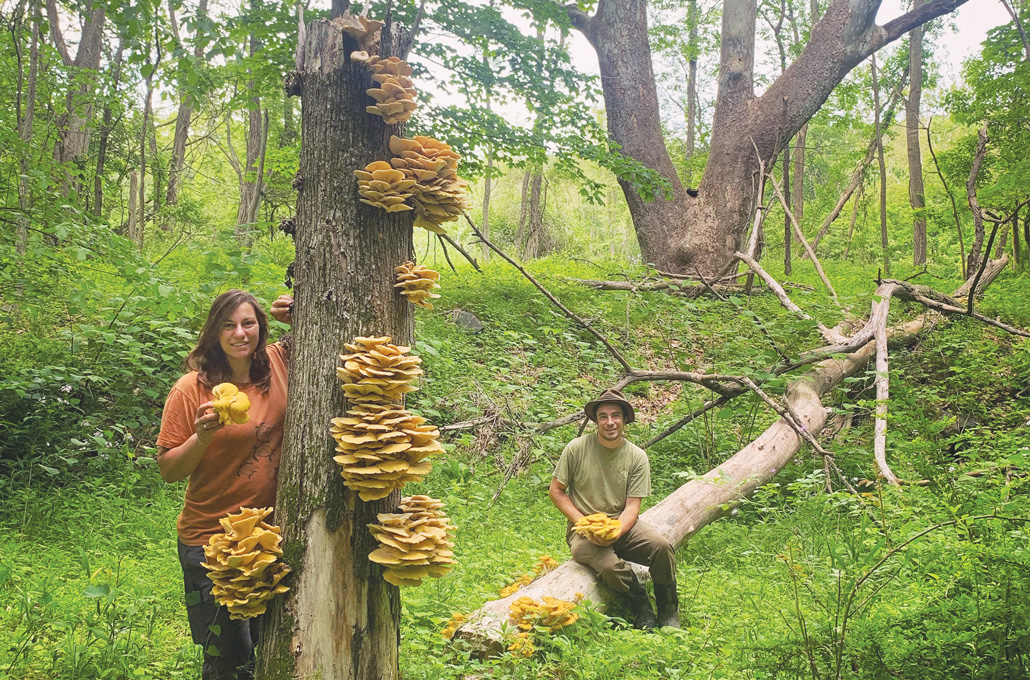 Anna Plattner and Justin Wexler practice forest farming, growing shiitake mushrooms on logs in wooded areas and collecting wild golden oyster mushrooms (shown) to sell at farmers markets and to local restaurants.Courtesy of Wild Hudson Valley
Anna Plattner and Justin Wexler practice forest farming, growing shiitake mushrooms on logs in wooded areas and collecting wild golden oyster mushrooms (shown) to sell at farmers markets and to local restaurants.Courtesy of Wild Hudson Valley
Anna Plattner and Justin Wexler have had to get creative to support their farm in New York’s Hudson Valley. The 38-hectare farm grows heirloom plants used by the Mohican and Munsee peoples indigenous to the region. The farm also incorporates traditional agroforestry methods, Wexler says. Rows of pawpaw and persimmon trees are staggered between native varieties of corn, beans and squash. The farm also grows more obscure foods, including hopniss, a legume that was a staple for some Native American tribes before Europeans arrived.
Wexler says he hopes that focusing on foods of Indigenous peoples can help others learn about the history and culture of the area. Demand for these unfamiliar crops isn’t high, so in addition to selling to wholesalers and restaurants, this year, Plattner and Wexler debuted monthly “wild harvest boxes” — a sort of local Blue Apron for native produce. The boxes come stuffed with snippets of history about the foods and recipe ideas. “Every plant has its own story to tell,” Plattner says.
Small farms may be more willing to embrace agroforestry, but to meet the looming challenges of climate change and biodiversity loss, large farms need to as well.
In the United States, “there is huge potential to scale up agroforestry,” says agroecologist Sarah Lovell, director of the Center for Agroforestry at the University of Missouri in Columbia.
For Lovell, step one involves identifying marginal areas on farms where trees could be planted with minimal disruption to the status quo, such as along creeks. Putting trees around waterways can reduce flooding and erosion, improve water quality and house wildlife, Lovell says. In the “true breadbasket of the Midwest,” she estimates, only 2 to 5 percent of such areas are currently making use of trees.
Eventually, she says she would like to see a drastic scaling up of alley cropping, with lines of fruit or nut trees fully integrated into fields. The need to move fruit and nut production east, away from increasingly drought-stricken California, may provide an extra push for bringing more trees onto monoculture farms, Lovell says.
But corn and soybean fields dominate much of U.S. agricultural land. These lucrative crops serve as raw materials for everything from biodiesel to high fructose corn syrup. To convince farmers to replace some of those crops with trees, the fruits of those trees will have to become more mainstream. The Savanna Institute, an agroforestry nonprofit in Madison, Wis., is focused on expanding the market for chestnuts and hazelnuts.
“We call them corn and soybean on trees,” says Savanna Institute ecologist Kevin Wolz. Chestnuts are about 90 percent starch, like corn; hazelnuts are 75 percent oil and protein, like soybeans, Wolz says. Researchers at the institute are working out just how these tree products could replace corn and soy as raw materials in production pipelines, with rows of nut trees breaking up monoculture fields. “We think these could be the next commodity crops that the Midwest can produce,” Wolz says.
Whether we’ll be drinking soda sweetened with chestnut syrup anytime soon remains to be seen. But to transform agriculture from a climate change problem to a solution, Wolz says such bold and imaginative thinking is essential.
Agroforestry isn’t a silver bullet for addressing climate change, the biodiversity crisis or food insecurity, Wolz says. But when applied with place and people in mind, he says it can be a Swiss Army knife.

Trustworthy journalism comes at a price.
Scientists and journalists share a core belief in questioning, observing and verifying to reach the truth. Science News reports on crucial research and discovery across science disciplines. We need your financial support to make it happen – every contribution makes a difference.
Subscribe or Donate Now

